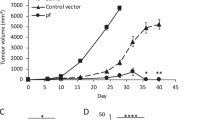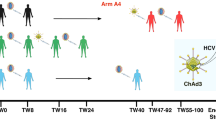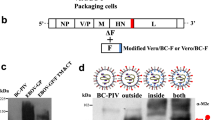Abstract
In DNA vaccination, CD4+ T-cell help can be enhanced by fusion of a gene encoding an immunization protein with a foreign gene or its part providing Th epitopes. To study the effect of helper epitope localization in a protein molecule, the influence of the vicinity of the helper epitope, and the impact of chimeric protein cellular localization, we fused the helper epitope p30 from tetanus toxin (TT, aa 947–967) with the N- or C-terminus of the mutated E7 oncoprotein (E7GGG) of human papillomavirus type 16, enlarged the p30 epitope with the flanking residues containing potential protease-sensitive sites and altered the cellular localization of the fusion constructs by signal sequences. The p30 epitope enhanced the E7-specific response, but only in constructs without added signal sequences. After localization of the fusion proteins into the endoplasmic reticulum and endo/lysosomal compartment, the TT-specific Th2 response was increased. The synthetic Pan DR epitope (PADRE) induced a stronger E7-specific response than the p30 epitope and its stimulatory effect was not limited to nuclear/cytoplasmic localization of the E7 antigen. These results suggest that in the optimization of immune responses by adding helper epitopes to DNA vaccines delivered by the gene gun, the cellular localization of the antigen needs to be taken into account.
This is a preview of subscription content, access via your institution
Access options
Subscribe to this journal
Receive 12 print issues and online access
$259.00 per year
only $21.58 per issue
Buy this article
- Purchase on Springer Link
- Instant access to full article PDF
Prices may be subject to local taxes which are calculated during checkout








Similar content being viewed by others
References
Assudani DP, Horton RB, Mathieu MG, McArdle SE, Rees RC . The role of CD4+ T cell help in cancer immunity and the formulation of novel cancer vaccines. Cancer Immunol Immunother 2007; 56: 70–80.
Bonehill A, Heirman C, Thielemans K . Genetic approaches for the induction of a CD4+ T cell response in cancer immunotherapy. J Gene Med 2005; 7: 686–695.
Demotz S, Lanzavecchia A, Eisel U, Niemann H, Widmann C, Corradin G . Delineation of several DR-restricted tetanus toxin T cell epitopes. J Immunol 1989; 142: 394–402.
Panina-Bordignon P, Tan A, Termijtelen A, Demotz S, Corradin G, Lanzavecchia A . Universally immunogenic T cell epitopes: promiscuous binding to human MHC class II and promiscuous recognition by T cells. Eur J Immunol 1989; 19: 2237–2242.
Ho PC, Mutch DA, Winkel KD, Saul AJ, Jones GL, Doran TJ et al. Identification of two promiscuous T cell epitopes from tetanus toxin. Eur J Immunol 1990; 20: 477–483.
Rice J, Dossett ML, Ohlen C, Buchan SL, Kendall TJ, Dunn SN et al. DNA fusion gene vaccination mobilizes effective anti-leukemic cytotoxic T lymphocytes from a tolerized repertoire. Eur J Immunol 2008; 38: 2118–2130.
Rice J, Elliott T, Buchan S, Stevenson FK . DNA fusion vaccine designed to induce cytotoxic T cell responses against defined peptide motifs: implications for cancer vaccines. J Immunol 2001; 167: 1558–1565.
Velders MP, Weijzen S, Eiben GL, Elmishad AG, Kloetzel PM, Higgins T et al. Defined flanking spacers and enhanced proteolysis is essential for eradication of established tumors by an epitope string DNA vaccine. J Immunol 2001; 166: 5366–5373.
Alexander J, Sidney J, Southwood S, Ruppert J, Oseroff C, Maewal A et al. Development of high potency universal DR-restricted helper epitopes by modification of high affinity DR-blocking peptides. Immunity 1994; 1: 751–761.
Ishioka GY, Fikes J, Hermanson G, Livingston B, Crimi C, Qin M et al. Utilization of MHC class I transgenic mice for development of minigene DNA vaccines encoding multiple HLA-restricted CTL epitopes. J Immunol 1999; 162: 3915–3925.
Hung CF, Tsai YC, He L, Wu TC . DNA vaccines encoding Ii-PADRE generates potent PADRE-specific CD4+ T-cell immune responses and enhances vaccine potency. Mol Ther 2007; 15: 1211–1219.
Moudgil KD, Sercarz EE, Grewal IS . Modulation of the immunogenicity of antigenic determinants by their flanking residues. Immunol Today 1998; 19: 217–220.
Carmicle S, Steede NK, Landry SJ . Antigen three-dimensional structure guides the processing and presentation of helper T-cell epitopes. Mol Immunol 2007; 44: 1159–1168.
Smahel M, Sima P, Ludvikova V, Vonka V . Modified HPV16 E7 genes as DNA vaccine against E7-containing oncogenic cells. Virology 2001; 281: 231–238.
Wolkers MC, Toebes M, Okabe M, Haanen JB, Schumacher TN . Optimizing the efficacy of epitope-directed DNA vaccination. J Immunol 2002; 168: 4998–5004.
Landry SJ . Three-dimensional structure determines the pattern of CD4+ T-cell epitope dominance in influenza virus hemagglutinin. J Virol 2008; 82: 1238–1248.
Diethelm-Okita BM, Okita DK, Banaszak L, Conti-Fine BM . Universal epitopes for human CD4+ cells on tetanus and diphtheria toxins. J Infect Dis 2000; 181: 1001–1009.
Liu MA . DNA vaccines: an historical perspective and view to the future. Immunol Rev 2011; 239: 62–84.
Accolla RS, Tosi G . Optimal MHC-II-restricted tumor antigen presentation to CD4+ T helper cells: the key issue for development of anti-tumor vaccines. J Transl Med 2012; 10: 154.
Stevenson FK, Ottensmeier CH, Rice J . DNA vaccines against cancer come of age. Curr Opin Immunol 2010; 22: 264–270.
Wu TC, Guarnieri FG, Staveley OK, Viscidi RP, Levitsky HI, Hedrick L et al. Engineering an intracellular pathway for major histocompatibility complex class II presentation of antigens. Proc Natl Acad Sci USA 1995; 92: 11671–11675.
Lin KY, Guarnieri FG, Staveley OK, Levitsky HI, August JT, Pardoll DM et al. Treatment of established tumors with a novel vaccine that enhances major histocompatibility class II presentation of tumor antigen. Cancer Res 1996; 56: 21–26.
Ji H, Wang TL, Chen CH, Pai SI, Hung CF, Lin KY et al. Targeting human papillomavirus type 16 E7 to the endosomal/lysosomal compartment enhances the antitumor immunity of DNA vaccines against murine human papillomavirus type 16 E7-expressing tumors. Hum Gene Ther 1999; 10: 2727–2740.
Fernandes DM, Vidard L, Rock KL . Characterization of MHC class II-presented peptides generated from an antigen targeted to different endocytic compartments. Eur J Immunol 2000; 30: 2333–2343.
Manoury B, Hewitt EW, Morrice N, Dando PM, Barrett AJ, Watts C . An asparaginyl endopeptidase processes a microbial antigen for class II MHC presentation. Nature 1998; 396: 695–699.
Jorgensen KW, Buus S, Nielsen M . Structural properties of MHC class II ligands, implications for the prediction of MHC class II epitopes. PLoS One 2010; 5: e15877.
Dean HJ, Fuller D, Osorio JE . Powder and particle-mediated approaches for delivery of DNA and protein vaccines into the epidermis. Comp Immunol Microbiol Infect Dis 2003; 26: 373–388.
Sudowe S, Ludwig-Portugall I, Montermann E, Ross R, Reske-Kunz AB . Transcriptional targeting of dendritic cells in gene gun-mediated DNA immunization favors the induction of type 1 immune responses. Mol Ther 2003; 8: 567–575.
Sudowe S, Dominitzki S, Montermann E, Bros M, Grabbe S, Reske-Kunz AB . Uptake and presentation of exogenous antigen and presentation of endogenously produced antigen by skin dendritic cells represent equivalent pathways for the priming of cellular immune responses following biolistic DNA immunization. Immunology 2009; 128: e193–e205.
Stoecklinger A, Eticha TD, Mesdaghi M, Kissenpfennig A, Malissen B, Thalhamer J et al. Langerin+ dermal dendritic cells are critical for CD8+ T cell activation and IgH gamma-1 class switching in response to gene gun vaccines. J Immunol 2011; 186: 1377–1383.
Kumar V, Bhardwaj V, Soares L, Alexander J, Sette A, Sercarz E . Major histocompatibility complex binding affinity of an antigenic determinant is crucial for the differential secretion of interleukin 4/5 or interferon gamma by T cells. Proc Natl Acad Sci USA 1995; 92: 9510–9514.
Constant SL, Bottomly K . Induction of Th1 and Th2 CD4+ T cell responses: the alternative approaches. Annu Rev Immunol 1997; 15: 297–322.
Oosterhuis K, Aleyd E, Vrijland K, Schumacher TN, Haanen JB . Rational design of DNA vaccines for the induction of human papillomavirus type 16 E6- and E7-specific cytotoxic T-cell responses. Hum Gene Ther 2012; 23: 1301–1312.
Jainchill JL, Aaronson SA, Todaro GJ . Murine sarcoma and leukemia viruses: assay using clonal lines of contact-inhibited mouse cells. J Virol 1969; 4: 549–553.
Smahel M, Sima P, Ludvikova V, Marinov I, Pokorna D, Vonka V . Immunisation with modified HPV16 E7 genes against mouse oncogenic TC-1 cell sublines with downregulated expression of MHC class I molecules. Vaccine 2003; 21: 1125–1136.
Makoff AJ, Oxer MD, Romanos MA, Fairweather NF, Ballantine S . Expression of tetanus toxin fragment C in E. coli: high level expression by removing rare codons. Nucleic Acids Res 1989; 17: 10191–10202.
Smahel M, Pokorna D, Mackova J, Vlasak J . Enhancement of immunogenicity of HPV16 E7 oncogene by fusion with E. coli beta-glucuronidase. J Gene Med 2004; 6: 1092–1101.
Acknowledgements
We thank P Vesela and T Novakova for technical assistance. This work was supported by grants NT11541-4/2010 from the Ministry of Health of the Czech Republic, P501/12/1761 from the Czech Science Foundation, and ERDF OPPK CZ.2.16/3.1.00/24001.
Author information
Authors and Affiliations
Corresponding author
Ethics declarations
Competing interests
The authors declare no conflict of interest.
Rights and permissions
About this article
Cite this article
Smahel, M., Polakova, I., Duskova, M. et al. The effect of helper epitopes and cellular localization of an antigen on the outcome of gene gun DNA immunization. Gene Ther 21, 225–232 (2014). https://doi.org/10.1038/gt.2013.81
Received:
Revised:
Accepted:
Published:
Issue Date:
DOI: https://doi.org/10.1038/gt.2013.81



